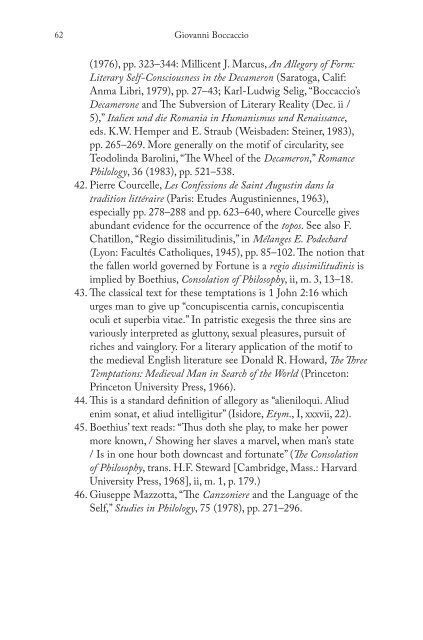Blooms Literary Themes - THE TRICKSTER.pdf - ymerleksi - home
Blooms Literary Themes - THE TRICKSTER.pdf - ymerleksi - home
Blooms Literary Themes - THE TRICKSTER.pdf - ymerleksi - home
You also want an ePaper? Increase the reach of your titles
YUMPU automatically turns print PDFs into web optimized ePapers that Google loves.
62<br />
Giovanni Boccaccio<br />
(1976), pp. 323–344: Millicent J. Marcus, An Allegory of Form:<br />
<strong>Literary</strong> Self-Consciousness in the Decameron (Saratoga, Calif:<br />
Anma Libri, 1979), pp. 27–43; Karl-Ludwig Selig, “Boccaccio’s<br />
Decamerone and Th e Subversion of <strong>Literary</strong> Reality (Dec. ii /<br />
5),” Italien und die Romania in Humanismus und Renaissance,<br />
eds. K.W. Hemper and E. Straub (Weisbaden: Steiner, 1983),<br />
pp. 265–269. More generally on the motif of circularity, see<br />
Teodolinda Barolini, “Th e Wheel of the Decameron,” Romance<br />
Philology, 36 (1983), pp. 521–538.<br />
42. Pierre Courcelle, Les Confessions de Saint Augustin dans la<br />
tradition littéraire (Paris: Etudes Augustiniennes, 1963),<br />
especially pp. 278–288 and pp. 623–640, where Courcelle gives<br />
abundant evidence for the occurrence of the topos. See also F.<br />
Chatillon, “Regio dissimilitudinis,” in Mélanges E. Podechard<br />
(Lyon: Facultés Catholiques, 1945), pp. 85–102. Th e notion that<br />
the fallen world governed by Fortune is a regio dissimilitudinis is<br />
implied by Boethius, Consolation of Philosophy, ii, m. 3, 13–18.<br />
43. Th e classical text for these temptations is 1 John 2:16 which<br />
urges man to give up “concupiscentia carnis, concupiscentia<br />
oculi et superbia vitae.” In patristic exegesis the three sins are<br />
variously interpreted as gluttony, sexual pleasures, pursuit of<br />
riches and vainglory. For a literary application of the motif to<br />
the medieval English literature see Donald R. Howard, Th e Th ree<br />
Temptations: Medieval Man in Search of the World (Princeton:<br />
Princeton University Press, 1966).<br />
44. Th is is a standard defi nition of allegory as “alieniloqui. Aliud<br />
enim sonat, et aliud intelligitur” (Isidore, Etym., I, xxxvii, 22).<br />
45. Boethius’ text reads: “Th us doth she play, to make her power<br />
more known, / Showing her slaves a marvel, when man’s state<br />
/ Is in one hour both downcast and fortunate” (Th e Consolation<br />
of Philosophy, trans. H.F. Steward [Cambridge, Mass.: Harvard<br />
University Press, 1968], ii, m. 1, p. 179.)<br />
46. Giuseppe Mazzotta, “Th e Canzoniere and the Language of the<br />
Self,” Studies in Philology, 75 (1978), pp. 271–296.

















